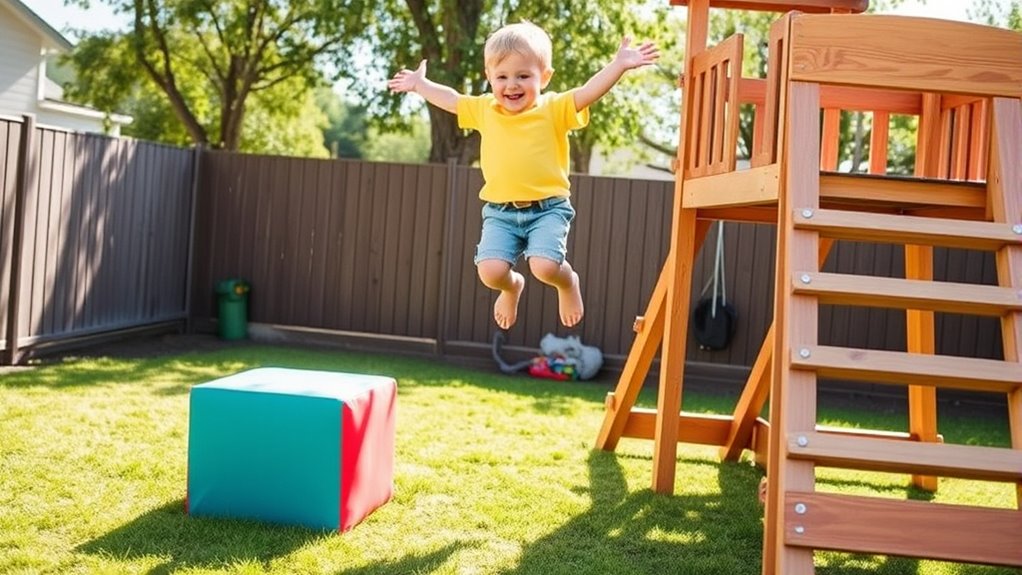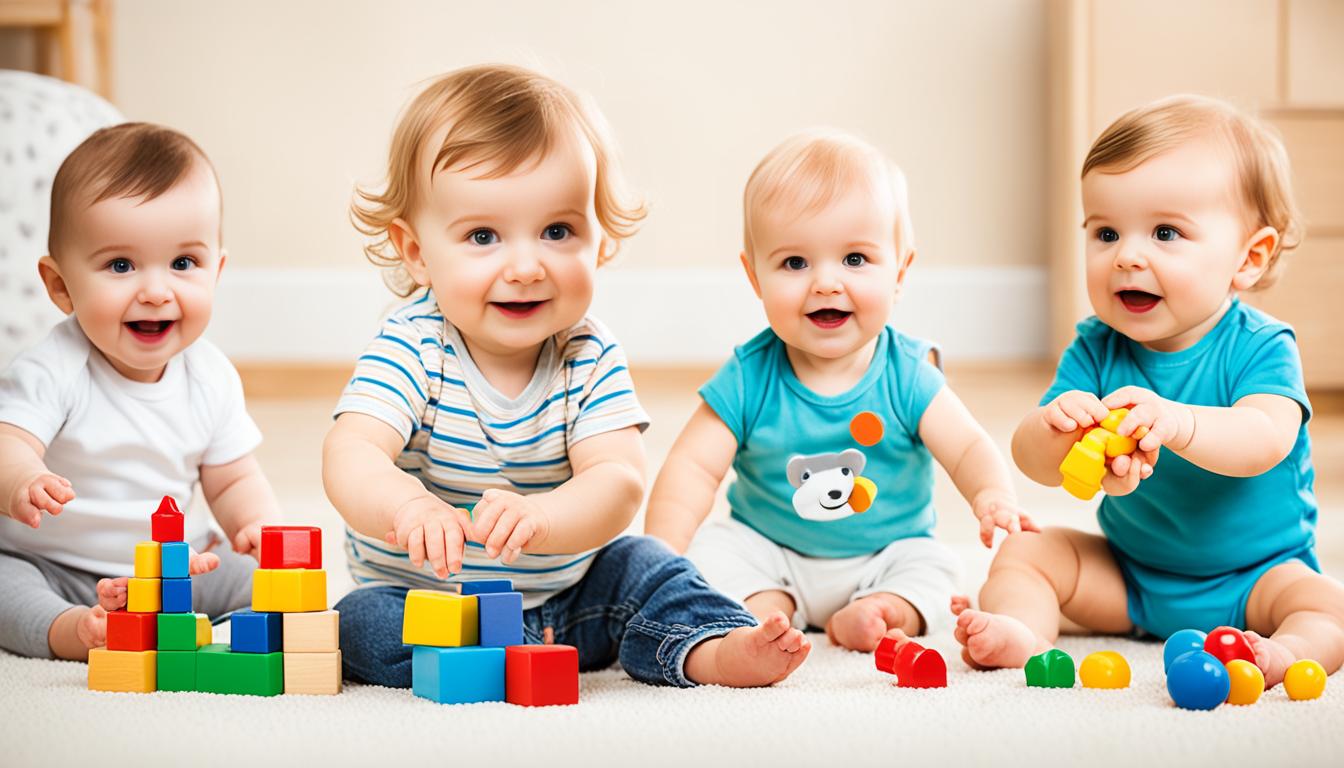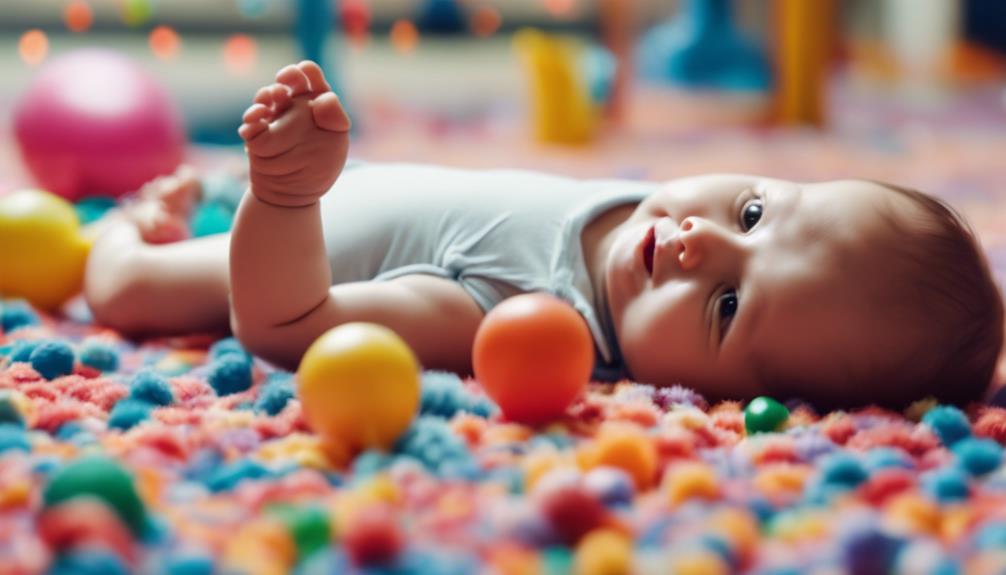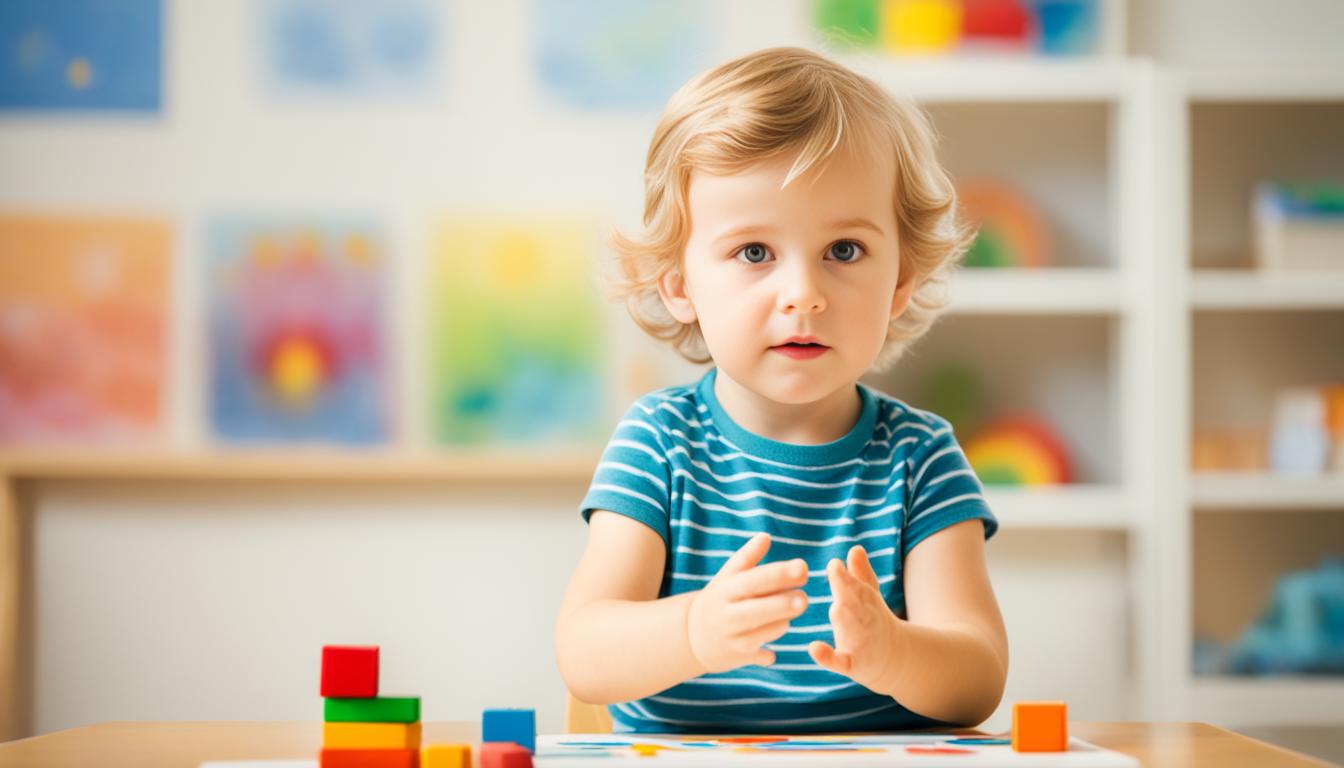To help your toddler practice climbing and jumping safely, create a secure play area with impact-absorbing surfaces like rubber mats and guarantee all equipment is sturdy, age-appropriate, and free of hazards. Supervise closely, teach proper techniques for controlled landings, and encourage confidence through gentle guidance and praise. Keep surfaces and play zones regularly checked for safety, and respond promptly to minor injuries. Keep exploring for more tips to support safer play and skill development.
Key Takeaways
- Provide age-appropriate equipment with secure, smooth edges and impact-absorbing surfaces like rubber mats or mulch.
- Teach toddlers proper climbing and jumping techniques, emphasizing controlled landings and good posture.
- Supervise all activities closely to prevent injuries and create a safe, well-lit play environment.
- Use positive reinforcement and celebrate small achievements to boost confidence and encourage skill development.
- Regularly inspect play surfaces and equipment for hazards, ensuring a safe space for exploration and practice.
Creating a Safe Play Environment for Climbing and Jumping
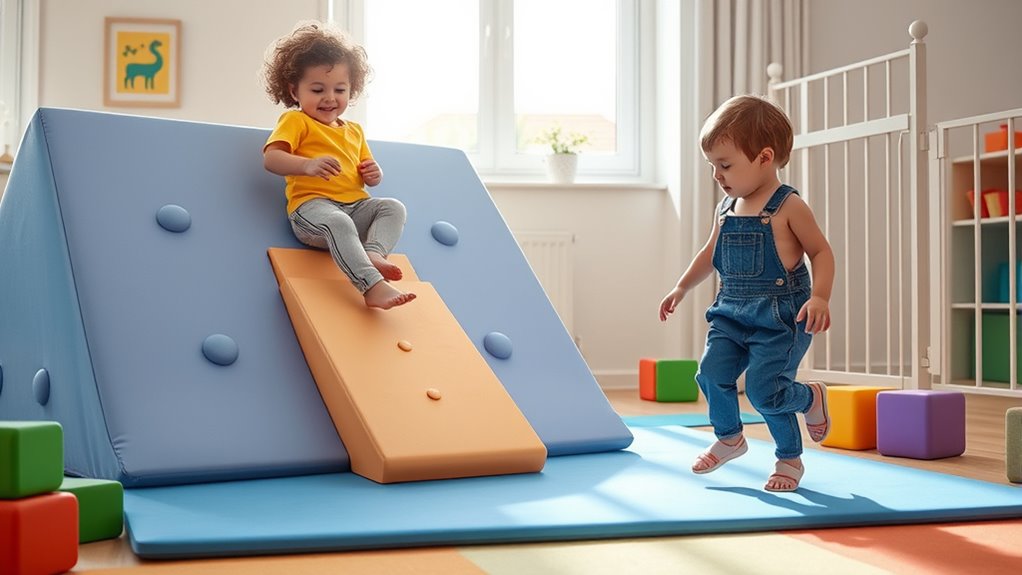
To guarantee children can enjoy climbing and jumping safely, you need to create a play environment that minimizes risks and promotes supervision. Start by inspecting all climbing equipment and ensuring it’s sturdy and well-maintained to support climbing safety. Use soft, impact-absorbing surfaces like rubber mats or mulch beneath play areas to cushion falls. Teach your child proper jumping techniques, emphasizing controlled landings and avoiding risky jumps. Keep a close eye during play to intervene quickly if safety is compromised. Remove any hazards, like sharp edges or loose objects, that could cause injury. Clear boundaries help children understand where they can climb or jump. Additionally, understanding the importance of contrast ratio can help in selecting appropriate lighting and colors in the play area to enhance visibility and safety. Creating a supervised environment ensures that adult oversight reduces the likelihood of accidents and builds your child’s confidence. Proper lighting and color contrast also play a crucial role in helping children see their surroundings clearly, thereby reducing accidents. Using visual cues such as bright borders or contrasting colors can further improve safety awareness. By setting up a safe environment and guiding proper techniques, you help your child develop confidence while reducing the risk of accidents. Incorporating proper safety gear such as helmets or knee pads can further protect your child during active play.
Choosing Age-Appropriate Equipment and Surfaces
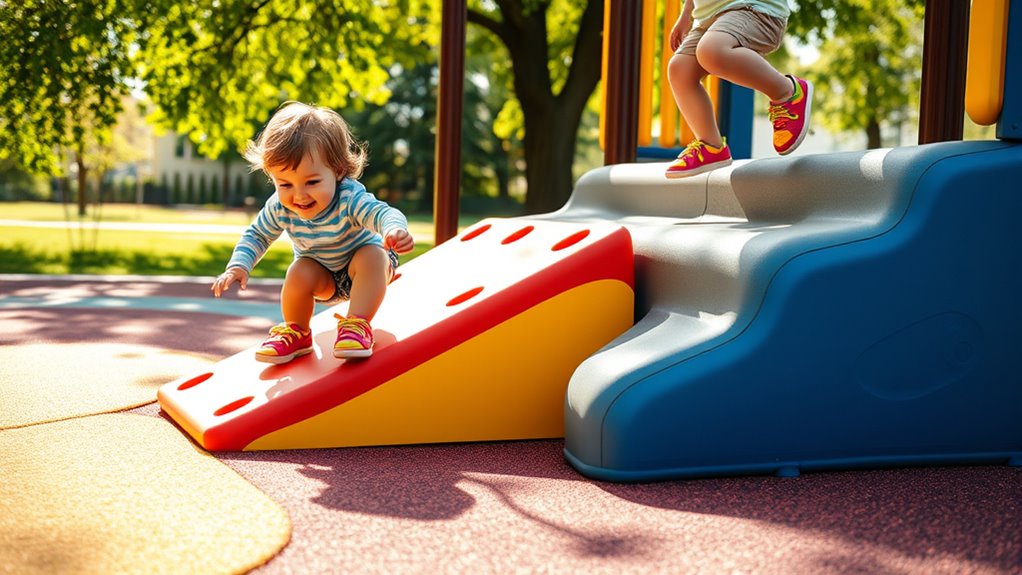
When selecting equipment and surfaces, you need to prioritize safe materials that won’t cause injuries. Make sure the surface options are appropriate for your child’s age and activity levels. Choosing the right combination helps create a safer environment for climbing and jumping fun. Additionally, using age-appropriate equipment designed specifically for your child’s developmental stage can significantly reduce the risk of accidents. Incorporating child safety standards into your selection process can further enhance safety measures.
Safe Material Choices
Choosing the right equipment and surfaces is essential for guaranteeing safety during climbing and jumping activities. When selecting mats or padding, consider textile options that are durable and non-toxic, making certain they won’t irritate your toddler’s skin. Look for cushioning materials that absorb impact effectively, reducing the risk of injury from falls. Avoid surfaces with loose fibers or rough textures that could cause abrasions. Opt for mats made from high-density foam covered in easy-to-clean, soft fabric to provide a safe landing zone. Make certain the materials are securely attached and don’t shift under pressure. Additionally, choose equipment with smooth edges and non-slip grips, so your little one can climb and jump confidently without unnecessary hazards. Proper material choices make a significant difference in creating a safe environment. Always verify that the surfaces and equipment meet safety standards for impact absorption to ensure maximum protection. Incorporating impact-absorbing materials such as shock-absorbing mats can further enhance the safety of your toddler’s play area and provide peace of mind. Using child-safe textiles that are free from harmful chemicals is also crucial for maintaining a healthy play space. Furthermore, selecting surfaces with tested slip resistance can prevent accidental slips and falls during active play.
Suitable Surface Options
Selecting the right surfaces and equipment tailored to your child’s age is crucial for safe climbing and jumping. For indoor activities, choose soft, shock-absorbing surfaces like foam mats or rubber flooring under indoor trampolines to cushion falls. When outdoor, opt for well-maintained outdoor climbing walls with textured grips and padded ground covers such as mulch or rubber tiles. These surfaces help minimize injury risks if your child slips or lands unexpectedly. Avoid hard concrete or asphalt areas for active play. Ensure the equipment itself is age-appropriate, with low heights and secure structures. Regularly inspect surfaces and equipment for wear and tear. Using appropriate surface cushioning significantly reduces injury severity during falls. Proper surface choices create a safer environment, allowing your toddler to explore and develop new skills confidently. Additionally, understanding the hours of operation of local retail stores can help plan shopping trips efficiently around your busy schedule. Implementing safety standards and staying informed about latest safety guidelines can further enhance your child’s safety during active play. Ensuring the surfaces are compliant with safety standards can provide added peace of mind for parents.
Supervision Strategies to Prevent Accidents
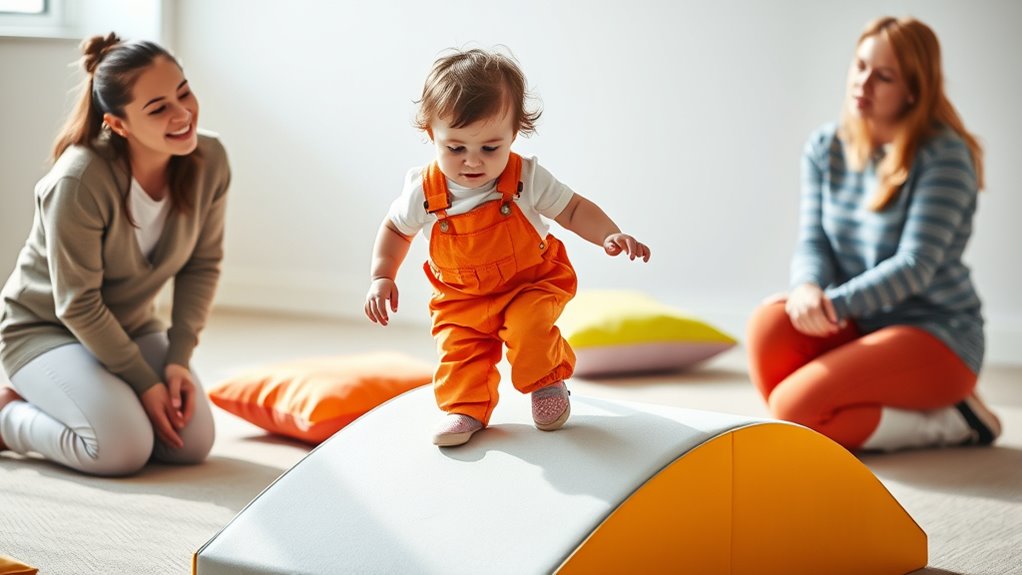
Supervision plays a crucial role in preventing accidents during climbing and jumping activities. To do this effectively, follow clear supervision guidelines that keep your child safe while encouraging independence. Conduct a risk assessment before each activity to identify potential hazards, such as unstable surfaces or overcrowded areas. Stay close enough to intervene quickly if needed, but also give your child space to explore. Keep a watchful eye on their movements, especially during challenging maneuvers. Remember to set boundaries and remind your child of safety rules. Consistent supervision helps you spot dangers early and teach safe practices. It’s also important to use appropriate safety equipment and ensure the play area is secure and well-maintained. Creating a safe play environment minimizes risks and promotes confident exploration. Being aware of Gold IRA regulations can help you understand the importance of safety and compliance in financial activities, paralleling the need for vigilance in play areas. Additionally, understanding cryptocurrency investments can help you recognize the importance of secure storage solutions, which are essential for protecting assets. Incorporating safety guidelines into your routine can further enhance your child’s protection during active play. By actively monitoring, you ensure your child’s play remains fun and accident-free, giving both of you peace of mind during these active moments.
Teaching Proper Climbing and Jumping Techniques
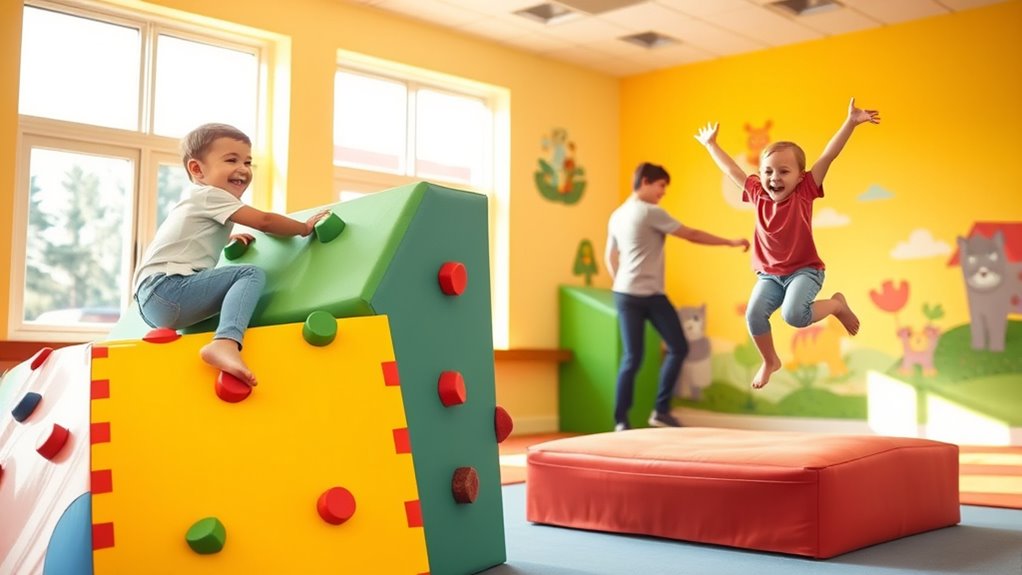
Teaching proper climbing and jumping techniques is essential to guarantee your child’s safety and confidence during active play. When climbing, focus on helping your child adopt a good climbing posture—keeping their body centered and using both hands and feet to maintain balance. Encourage steady movements and remind them to avoid rushing. For jumping, teach them to bend their knees slightly before takeoff and to land softly with their feet shoulder-width apart. Emphasize the importance of landing techniques that absorb impact, reducing strain on joints. Reinforce these skills consistently, offering gentle corrections and praise. Proper techniques not only minimize injuries but also build your child’s coordination and confidence, enabling them to explore and develop new skills safely. Incorporating visual cues can further help children understand correct form and improve their technique effectively.
Encouraging Confidence and Independence Safely
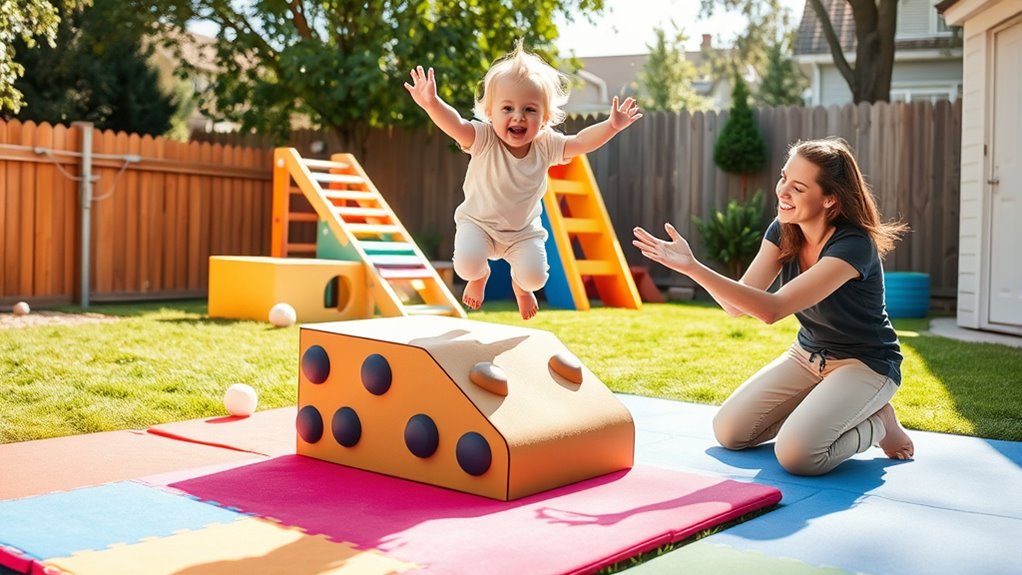
Building your child’s confidence and independence during active play is essential for their growth and safety. Your parental involvement shows support, helping them feel secure while trying new skills. Encourage peer encouragement by fostering a positive environment where children cheer each other on, boosting their self-esteem. To promote safe independence:
- Celebrate small achievements to motivate continued effort
- Offer gentle guidance instead of constant correction
- Create opportunities for your child to practice skills with friends in supervised settings
These strategies help your little one develop confidence without feeling overwhelmed. By combining your support with peer encouragement, you create a safe, empowering space for your toddler to explore and master climbing and jumping skills.
Recognizing and Responding to Minor Injuries
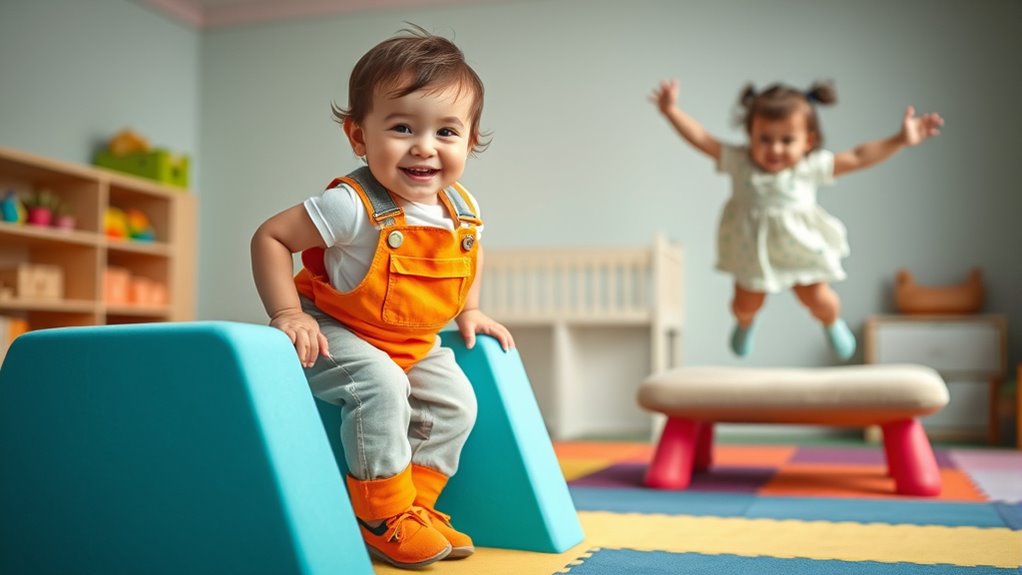
As children explore climbing and jumping, minor bumps and scrapes are often part of their active play. When injuries occur, quick and calm first aid helps prevent infection and eases your child’s discomfort. Keep a basic first aid kit nearby, with essentials like antiseptic, bandages, and ice packs. Always clean minor cuts gently and apply a bandage to prevent infection. Monitor your child for signs of more serious injury, such as excessive bleeding or swelling. Injury prevention is key—encourage safe climbing and jumping, supervise closely, and teach your child to recognize their limits. Responding promptly to minor injuries builds their confidence and teaches safety, making future play safer and more enjoyable. Staying attentive helps keep play fun without unnecessary setbacks.
Frequently Asked Questions
How Can I Tell if My Toddler Is Ready to Try Climbing and Jumping?
You can tell if your toddler is ready to try climbing and jumping by observing their development milestones and motor skill readiness. Look for signs like improved balance, coordination, and curiosity about movement. If they can pull themselves up, stand unsupported, and attempt small jumps with confidence, they’re likely prepared. Always supervise closely and provide safe environments to support their growth and ensure they practice new skills safely.
What Are Common Signs of Overexertion in Young Children During Play?
Did you know that overexertion is common in young children during active play? Signs include excessive fatigue, irritability, or refusing to continue playing. As a parent, you should prioritize parental supervision and regularly assess your child’s play area for safety. If your toddler shows these signs, it’s time to let them rest. Monitoring their cues helps prevent injuries and guarantees play remains fun and safe.
How Do I Handle a Toddler’s Fear of Climbing or Jumping?
When your toddler shows fear of climbing or jumping, focus on fear management by staying calm and patient. Use encouragement techniques like praising small efforts and offering reassurance. Gradually introduce the activity, maybe starting with easier options, so they build confidence. Remember, your support helps them feel safe and secure, making it easier to overcome fears and develop new skills at their own pace.
Are There Specific Safety Guidelines for Outdoor Versus Indoor Play Areas?
When evaluating outdoor versus indoor play areas, you should prioritize equipment safety and supervision strategies. For outdoor spaces, check that equipment is sturdy, well-maintained, and free of sharp edges. Keep a close eye on your toddler at all times, especially around uneven surfaces or open spaces. Indoors, make certain soft flooring and secure furniture. Consistently supervise and adapt safety measures to suit each environment, helping your toddler explore confidently and safely.
When Should I Consult a Pediatrician About My Child’s Climbing and Jumping Activities?
When your toddler reaches key developmental milestones like walking steadily, climbing, and jumping, you should consult a pediatrician. Watch for signs of delays, difficulty, or discomfort during these activities. Pediatric advice can help guarantee your child’s safety and proper development. If your child shows persistent hesitation, pain, or fails to meet milestones, seek professional guidance promptly. Your pediatrician can provide personalized recommendations to support healthy growth and activity.
Conclusion
By creating a safe space, supervising closely, and teaching proper techniques, you’ll help your toddler build confidence like a sturdy foundation. Remember, every fall is just a step toward mastering new skills, as long as you’re there to catch them. With patience and care, you’re guiding their journey from cautious steps to confident leaps, turning their curiosity into a lifelong love of movement. You’re planting the seeds for safe adventures that will grow stronger with each try.

